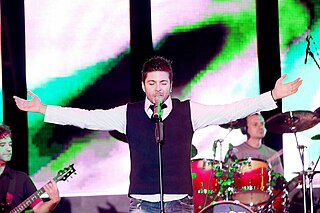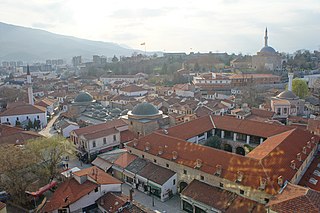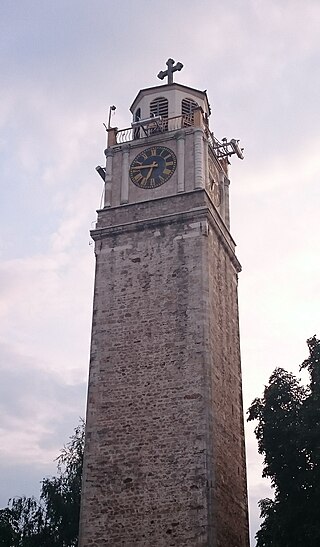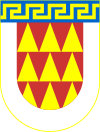
Bitola is a city in the southwestern part of North Macedonia. It is located in the southern part of the Pelagonia valley, surrounded by the Baba, Nidže, and Kajmakčalan mountain ranges, 14 kilometres north of the Medžitlija-Níki border crossing with Greece. The city stands at an important junction connecting the south of the Adriatic Sea region with the Aegean Sea and Central Europe, and it is an administrative, cultural, industrial, commercial, and educational centre. It has been known since the Ottoman period as the "City of Consuls", since many European countries had consulates in Bitola.

Heraclea Lyncestis, also transliterated Herakleia Lynkestis, was an ancient Greek city in Macedon, ruled later by the Romans. Its ruins are situated 2 km (1.2 mi) south of the present-day town of Bitola, North Macedonia. In the early Christian period, Heraclea was an important Episcopal seat and a waypoint on the Via Egnatia that once linked Byzantium with Rome through the Adriatic seaport of Dyrrachium. Some of its bishops are mentioned in synods in Serdica and other nearby towns. The city was gradually abandoned in the 6th century AD following an earthquake and Slavic invasions.

Stobi or Stoboi, was an ancient town of Paeonia, later conquered by Macedon, and finally turned into the capital of the Roman province of Macedonia Salutaris. It is located near Gradsko, North Macedonia, on the main road that leads from the Danube to the Aegean Sea and is considered by many to be the most famous archaeological site in North Macedonia. Stobi was built where the Erigon joins the Axios (Vardar), making it strategically important as a center for both trade and warfare.

Todor Proeski was a Macedonian singer and songwriter. Considered a top act of the local Macedonian and Balkan music scene, Proeski's music was popular across multiple countries in Southeast Europe. He was dubbed the "Elvis Presley of the Balkans" by BBC News. He died in a car crash on the Zagreb–Lipovac A3 highway, near Nova Gradiška in Croatia, on the morning of 16 October 2007, aged 26.

Petar Miloševski Stadium is a football stadium in Bitola, North Macedonia and the home of FK Pelister. The stadium is divided into two stands: North, which consists of 4,500 seats among which is the press box along with the team pads, and the South, which consists mainly of the Pelister supporters and seats about 5,000. When the final construction project is complete, the stadium will have a capacity of 10,000.
Ethnic Croats form a small minority North Macedonia. As of 2002, there were 2,686 declared Croats living in the country. They mostly live in the capital city Skopje, the second largest city Bitola and around Lake Ohrid.

Macedonia Square is the main square of Skopje, the capital of North Macedonia. The square is the biggest in North Macedonia with a total extent of 18,500 m2. It is located in the central part of the city, and it crosses the Vardar River. The Christmas festivals are always held there and it commonly serves as the site of cultural, political and other events. The independence from Yugoslavia was declared here by the first president of Macedonia, Kiro Gligorov. The square is part of the Skopje 2014 project.

Tourism in North Macedonia is a large factor of the nation's economy. The country's large abundance of natural and cultural attractions make it suitable for tourism.

The Vergina Sun, also known as the Star of Vergina, Vergina Star or Argead Star, is a rayed solar symbol first appearing in ancient Greek art of the period between the 6th and 2nd centuries BC. The Vergina Sun proper has sixteen triangular rays, while comparable symbols of the same period variously have sixteen, twelve, eight or (rarely) six rays.
The national symbols of North Macedonia, as stated in the constitution, are the coat of arms, the flag and the anthem. After the independence of North Macedonia from Yugoslavia, the country made some changes in the national symbols. The flag was changed two times and today's flag includes an eight-ray sun on a red background, while the coat of arms from the Socialist Republic of Macedonia was retained, except the red star which was removed.

The Old Bazaar also known as Turkish Bazaar is a bazaar located in Skopje, North Macedonia, situated on the eastern bank of the Vardar River, stretching from the Stone Bridge to the Bit-Pazar and from the Skopje Fortress to the Serava river. The Old Bazaar falls primarily within the borders of Čair Municipality but a part of it is located in Centar Municipality. As one of the oldest and largest marketplaces in the Balkans, it has been Skopje's centre for trade and commerce since at least the 12th century.

The Skanderbeg Square is the main plaza in the centre of Tirana, Albania. The square is named after the Albanian national hero Gjergj Kastrioti Skënderbeu. The total area is about 40,000 square metres. The Skanderbeg Monument dominates the square.

Skopje 2014 was a project financed by the Macedonian government of the then-ruling nationalist party VMRO-DPMNE, with the official purpose of giving the capital Skopje a more classical appeal but designed more earthquake-proof. The project, officially announced in 2010, consisted mainly of the construction of colleges, museums and government buildings, as well as the erection of monuments depicting historical figures from the region of Macedonia. Around 20 buildings and over 40 monuments were to be constructed as part of the project.

Magnolia Square is a public space and a town square of the City of Bitola, located near the Clock Tower. Around the square are old houses from the Macedonian and Ottoman architecture that are purchased from various companies, firms and coffee bars. Bitola, which was a major cultural center in the Ottoman Empire has very interesting buildings from the Turks from which many on Main Street and Magnolia Square. Also there is an art gallery "Magaza" and the newly built "Glass Building". Bitola in cooperation with the Government of Macedonia made the monument The Founder of Heraclea Statue that is 8.5m high and around it a fountain with the Vergina Sun on it, and benches for sitting and resting.

The Clock Tower of Bitola, known as Saat Kula, is a clock tower and one of the landmarks of the Macedonian city of Bitola. The clock tower in Bitola is a very practical monument aiding people with the time of day.

Freedom Square in Bydgoszcz is located in Bydgoszcz, Poland, in downtown area, between Gdańska Street and the park Casimir the Great.
Eden na Eden is a Macedonian talk show that airs weekly on Kanal 5 TV. It is the highest rated talk show in the country and it is hosted by Žarko Dimitrioski, prominent media personality in Macedonia.

Tomislav Jagurinovski is a Macedonian handball player for RK Vardar 1961 and the Macedonian national team.

Stefan Markovski is a contemporary Macedonian writer, screenwriter, poet, philosopher and translator.
















